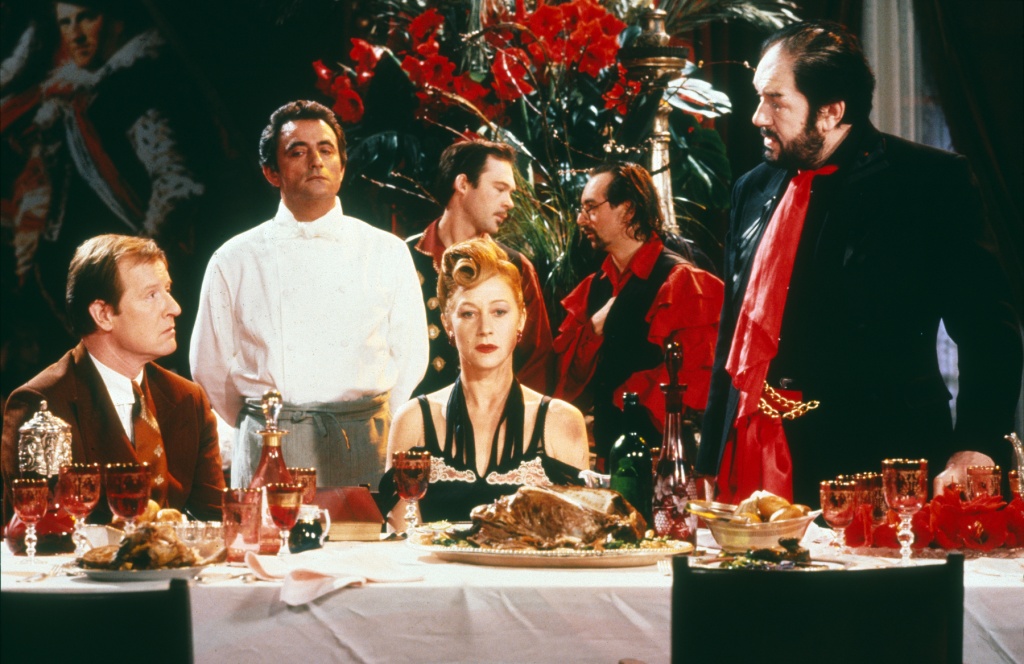

Because of this, the design of the film becomes AS important as the framework, if not more so. These factors are important to the narrative, as they are symbolic to what Greenaway is trying to convey, as well as what the characters are all about. The architecture of the sets too, and the way in which the production designers have chosen to dress them also adds to the artistic stylisation of the film.

The reason that some define this as artistic refers to the use of colour, light and composition. But it's also as artistic a film as you can get a fact that some here have disputed. Some have clearly found the film's various abstractions problematic (yes, it is theatrical, yes it is occasionally shocking, and yes, it does evolve in a world of its own ostentatious creation). It's an audacious move, but one that pays off in the creation of a completely self-contained world something that is further established by Sacha Vierny's sumptuous cinematography and the wonderfully bombastic music of the ever-excellent Michael Nyman. Greenaway even breaks continuity by having Helen Mirren's costumes change colour as she moves through each room of the restaurant, so that we have a green dress in the kitchen, a red dress in the dinning area (inspired by Hitchcock's vertigo no less) and a white dress in the lavatory. The costumes by Jean Paul Gaultier scream over-the-top chic, whilst often mirroring the use of colour employed by the production designers. Everything here is about pushing things beyond the reasonable limitations so we have a stunningly intricate set that is both theatrically simplistic, but also as other-worldly as anything from the work of say Gilliam or Jeunet. It is also elevated by the impeccable cinematic qualities that we hold synonymous with the director's work. This is mixed in with the socio-political undertones as well as Greenaway's many references to art, theatre, film and literature. The plot is a simple construct centred on the theme of revenge and the need for personal freedom. He also elevates the film beyond the realms of mere art-house experimentation by fashioning a seriously funny script, which has ample opportunities for central character Albert Spica to prove himself the ultimate charismatic bully - part cockney hard man, part pantomime villain - who is never less than compulsively terrifying. His ability to craft characters and situations that resonate beyond the context of a particular scenario, coupled with his bitterness and unwillingness to conform is what sets him up as a satirist of serious note. The characters that he chooses to put forward to the audience as protagonists are archetypes of social and political caricatures that we would find in that particular decade but heightened to conform to the over-the-top opulence/pestilence found central to the plot. Starring Julia Ormond and Ralph Fiennes.With the Cook, the Thief, his Wife and her Lover, Greenaway creates a self-contained world that is both a fabrication and abstraction of reality, but also an extremist reflection (nee, microcosm) of British society in the nineteen-eighties. Despite the controversy surrounding the film’s nudity and graphic content at release, THE BABY OF MÂCON is a stunning and thoughtful exploration of the Nativity through the eyes of a fascinated atheist. What follows is a play-within-a-film that assaults all the senses through the reenactment of extreme violence and cruelty within the story of a baby supposedly born to a self-proclaimed virgin in a town in which all women have become barren. Set in 17th century France, Peter Greenaway’s brutal and disturbing vision follows Cosimo III de’ Medici and his court, as they gather to watch a performance of a 15th century play. THE BABY OF MÂCON, 1993, Shout! Factory, 122 min, Netherlands/France/UK, Dir: Peter Greenaway. This disturbing, visually audacious black comedy is Greenaway’s unholiest masterpiece.

Michael Gambon stars as a gangster who gorges himself at the restaurant he owns while his disaffected wife (Helen Mirren) plays gourmet food games in the kitchen with her lover (Alan Howard). THE COOK, THE THIEF, HIS WIFE & HER LOVER, 1989, Universal, 124 min, Netherlands/UK/France, Dir: Peter Greenaway.


 0 kommentar(er)
0 kommentar(er)
